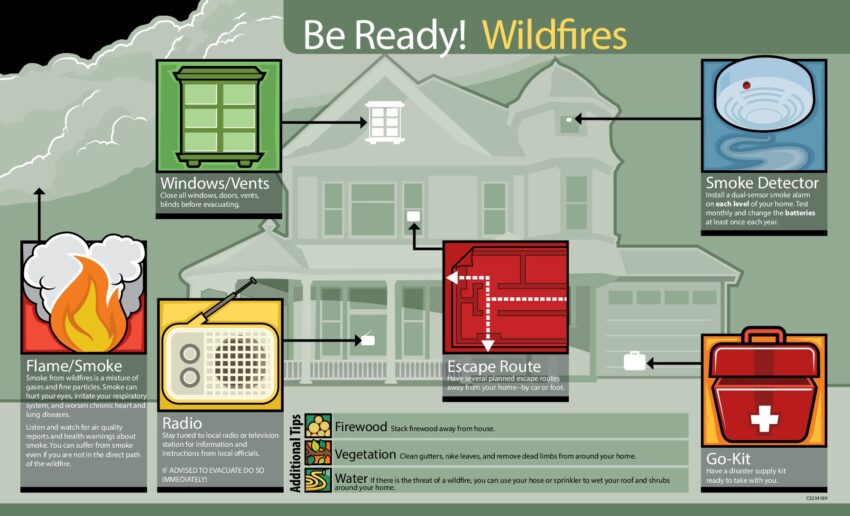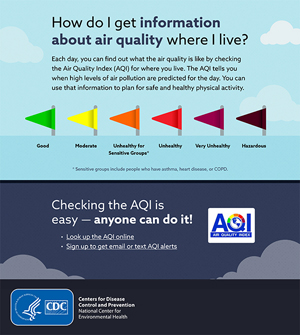
Share On Social!
Many in the US East Coast recently experienced heavy smoke exposure due to a series of wildfires burning in Canada.
“This Canadian crisis has not been limited to the Great North. Smoke from the fires has spread across a large portion of the U.S., affecting air quality for millions across the East Coast, as the fires rage on without signs of stopping,” according to CBS News.
This has further brought attention to the importance of wildfire safety.
Let’s dive into this issue, how it impacts others, and key safety tips everyone should know!
How Do Wildfires and Smoke Impact Safety?
Dry conditions in much of the US can increase the potential for wildfires in or near wilderness areas, which can cause harmful smoke, according to the CDC.
“This smoke can hurt your eyes, irritate your respiratory system, and worsen chronic heart and lung diseases,” the CDC states.
Several groups and individuals can have greater risks from wildfire smoke:
- People who have lung diseases like COPD or asthma, or heart disease.
- Older adults, due to their increased risk of heart and lung diseases.
- Children, due to their airways are still developing, and they breathe more air per pound of body weight than adults. Children often also spend more time outdoors engaged in activity and play.
- Those who experience Toxicant Induced Loss of Tolerance (TILT), or chemical intolerance.
- Expecting mothers because of physical changes during pregnancy, like increased breathing rates. Expectant mothers may also be at risk for problems like preterm birth and babies born with low birth weight.
Tiny toxins—PM2.5 (pollution particles measuring 2.5 micrometers or less)—commonly known as “combustion particles” come from these fires and can cause severe health impacts, according to a Salud America! resource.
“We are increasingly concerned about particulate matter air pollution and other forms of air pollution,” Dr. Joel Kaufman, professor of environmental and occupational health sciences, medicine and epidemiology at the University of Washington in Seattle, told the American Heart Association. “There’s increasing evidence that certain pollutants are associated with cardiac disease, heart attacks, and stroke. At certain times of the year, wood burning is a major source of that pollution.”
How Do You Find Out If Wildfires and Smoke Are Near You?
Review national fire-tracking sources.
The New York Times is tracking air quality from the Canadian wildfires.
AirNow’s “Fire and Smoke Map” is mapping fires throughout North America.
You can also listen to the Emergency Alert System (EAS) and National Oceanic and Atmospheric Administration (NOAA) Weather Radio for emergency alerts.
Check local visibility guides. Some communities measure the amounts of particles in the air.
“In the Western United States, some states and communities have guidelines to help people determine if there are high levels of particulates in the air by how far they can see,” according to the CDC.
How Do You Protect Yourself and Stay Safe amid Wildfires and Smoke?
First, read more about preventing wildfires and what to do before, during, and after a wildfire.
Then consider preparing for wildfires.
Learn your community’s evacuation plan and find several ways to leave your area. It’s also important to have emergency plans for pets and livestock.
Gather emergency supplies, like respirators, which filter out smoke or ash before you can breathe it in.
“Take only essential items with you. Follow designated evacuation routes–others may be blocked–and plan for heavy traffic,” the CDC reports.
Get an extensive list of ways to reduce risks from wildfire smoke in English and Spanish.
“You can take steps to be ready for a wildfire and prepare your home and landscaping to reduce your risk from a wildfire,” according to the CDC.
How Do We Focus on Preventing Wildfires and Smoke Pollution?
Recently, Secretary of Health and Human Services, Xavier Becerra shared a Twitter thread with a plea to focus on climate change.
Climate change is an ongoing environmental dilemma that threatens the health of all people.

Yet, research has shown that certain groups, such as Latinos and other people of color, immigrants, those with a lower socio-economic status, and vulnerable occupational groups are most likely to suffer longer and more severely from climate change.
“[The wildfires and smoke on the US East Coast are] another stark reminder of how the climate crisis is disrupting communities across the country & why it’s been a priority for @POTUS since day one,” Becerra tweeted. “As we work to help all those impacted by these recent fires, we must continue to invest in tackling the climate crisis.”
Find out how to get involved to address climate issues!
The National Center for Healthy Housing (NCHH) also spoke to 17 experts who work around wildfires to identify where public health and healthy housing can support each other.
The Wildfire Interviews: Summary And Key Takeaways tackles a wide range of issues including:
- Reaching vulnerable and high-risk populations.
- Messaging formats, delivery methods, and timing.
- Built environment and home modifications
“Partnerships with community organizations are critical to reaching populations impacted by smoke, and these organizations need to be financially supported in this work,” according to the report.
The complete summary can be found here.
Health in Your Community
Looking for a way to measure health in your area?
Explore Salud America!’s Health Equity Report Card.
Find data on your county’s air toxics exposure, Environmental Justice Index, and Respiratory Hazard Index score.
Compare the data to other counties and states across the country. Share your results with city leaders and health organizations to advocate for change in your community.
“You can share an interactive version of your local Health Equity Report Card with decision-makers to build the case to address existing systemic inequities in your community so that everyone has a fair, just opportunity to live their healthiest lives possible,” said Dr. Amelie G. Ramirez, director of Salud America! at the Institute for Health Promotion Research in the Department of Population Health Sciences at UT Health San Antonio.
GET YOUR HEALTH EQUITY REPORT CARD!
Explore More:
Air QualityBy The Numbers
24
percent
of Mexican American-nonsmokers are exposed to secondhand smoke



